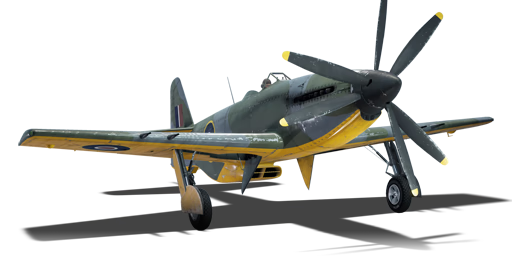



The MB.5 is a premium British fighter. It was introduced as a premium pack in Update 1.77 "Advancing Storm". It was removed from the store after the 2019 Victory Day Sale, but was reintroduced briefly for the 2018 "Royal Air Force Centenary" and purchasable in-game with Golden Eagles for War Thunder's 7th Anniversary.
The MB.5 is usually played as an interceptor or an air superiority fighter, due to its high speed and hard-hitting armament. Add into the equation a contra-rotating propeller, and you have the perfect combination of the best aircraft of two nations.
The MB.5 is an unusual plane by the standards of British aircraft. It seems like it should be an American aircraft due to its shape, but yet it is not. In fact, it behaves almost as your average P-51D Mustang would- it even looks like a Mustang, only with the nose of a Spitfire. What sets it apart from most Rank IV planes is the presence of a contra-rotating propeller, which is also found on the Wyvern S4. The MB.5 is different than the Mustang in the armament it carries- four 20 mm Hispano Mk.II cannons rather than six .50 cals. The MB.5 has a high climb rate, as is expected of most British planes, which is nice for competing with same-tier German and Soviet fighters. In short, the MB.5 is a sort of symbiosis of a Spitfire and a Mustang, which can be a match-deciding plane in the right hands. Though the turn rate is generally below average, at high speeds the MB.5 can conduct shockingly quick turns to catch even dogfighters by surprise. The huge power of the engine also allows for lower speed bleed in vertical manoeuvres.
flaps
flaps
flaps
brake
| Belt | Belt filling | Armor penetration (mm) at a distance: | |||||
|---|---|---|---|---|---|---|---|
| 10 m | 100 m | 500 m | 1000 m | 1500 m | 2000 m | ||
| HEI/SAP-I/T | 22 | 20 | 14 | 9 | 6 | 4 | |
| AP-T/HEI/SAP-I | 37 | 35 | 25 | 16 | 10 | 7 | |
| T/HEI/SAP-I/HEI/SAP-I | 22 | 20 | 14 | 9 | 6 | 4 | |
| AP-T/T/HEI | 37 | 35 | 25 | 16 | 10 | 7 | |
| AP-T/SAP-I/HEI/AP-T | 37 | 35 | 25 | 16 | 10 | 7 | |
| HEI/HEI/SAP-I | 22 | 20 | 14 | 9 | 6 | 4 | |







 2 x (90 / 225 / 450) %
2 x (90 / 225 / 450) % 
 2 x 166 %
2 x 166 % 

Flight performance | |
|---|---|
Survivability |
|---|
Weaponry |
|---|